The Go Direct SpectroVis Plus Spectrophotometer: Listening to Plants (Part 2)
By Martin Horejsi
Posted on 2019-02-05
Continuing the story of the Vernier Go Direct SpectroVis Plus Spectrophotometer, we will now apply its power it for a more traditional use; to inspect the transmission and absorption of fluid or a material suspended in a fluid. And that fluid can be easily and quickly generated with little more than a sample of plant leaf and some isopropyl alcohol.
Plant leaves like some light wavelengths but not others. They tell us there preferences through their absorbance spectrum. They tell us their dislikes by their transmission spectrum. A simple, popular and highly effective demonstration of the Go Direct SpectroVis Plus Spectrophotometer’s power is with a basic inspection of the transmission (reflection) and absorption spectrum of a some green fluids generated from leaves. Essentially plants can tell us their story through their spectrum and the Go Direct SpectroVis Plus Spectrophotometer acts like a translator so we can understand what the plants have to say.
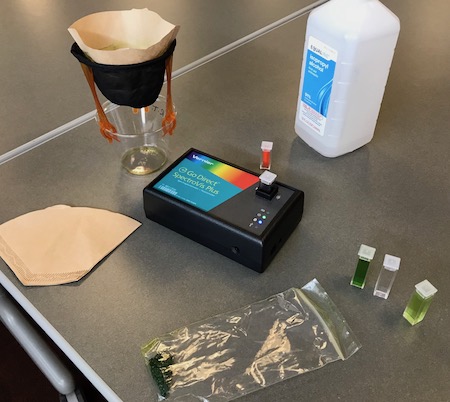
Preparing the magic juice for the Go Direct SpectroVis Plus Spectrophotometer involves nothing more than a mix of isopropyl alcohol (95% preferred) and a sample of the plant leaf in question. For this example I used a piece of kale leaf. With leattuce and softer leaved veggies, its possible to grind the leaves by hand in a plastic bag into a beautiful green liquid. The kale, on the other hand, is a much more durable leaf so I poured the solution into a bowl and ground the mix with a spoon. Of course a mortar and pestle would be more suited for this job.
On a side note, it has been found that lower than 95% alcohol can act as an opaque material at very short wavelengths like those in the UV around 200 nanometers. While that is far below anything we are looking at, or can even detect with our test instrument and plastic cuvette, it should be noted where and how this limitation expresses itself.
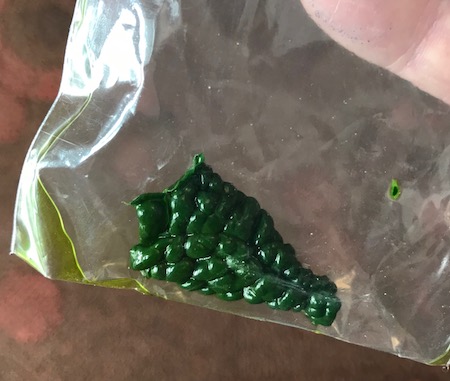
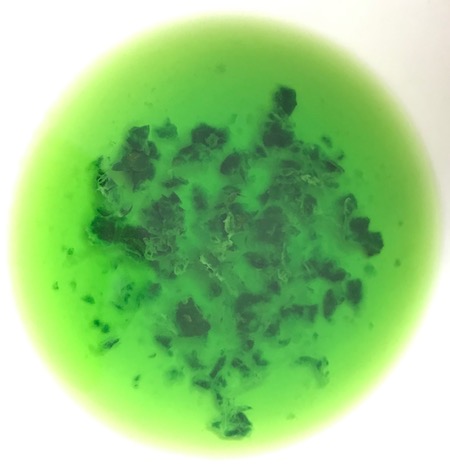
The green kale soup was then poured through a simple coffee filter and the green fluid dripped into the little vessel, or in French, cuvette. So hip is the ubiquitous transparent box that the cuvette even has its own Wikipedia page.
The cuvettes I’ll be using are plastic, about 1.5ml, and 15 of them with lids are included in the purchase of the Go Direct SpectroVis Plus Spectrophotometer. Something I did, that could be handled professionally, is that I took one of the cuvettes and cut it down to a smaller size flush with the top surface of the Go Direct SpectroVis Plus Spectrophotometer. I rolled up a piece of orange material inserted it into minimized cuvette, then glued the lid down tight. This special cuvette blank is for transport and storage in the spectrometer to keep debris, dust, etc. from entering the unit while in the field. As a Bluetooth device, the Go Direct SpectroVis Plus Spectrophotometer will be used in less than sterile lab conditions.
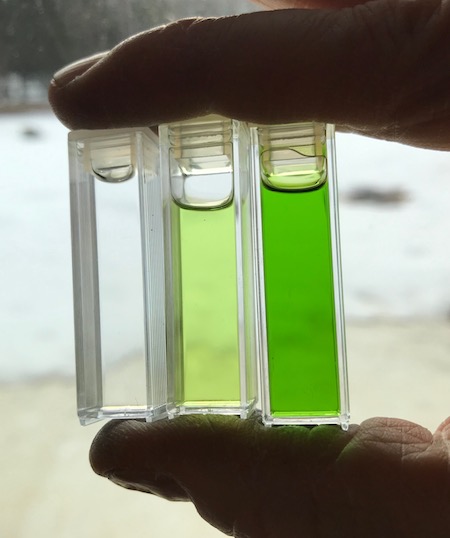
There are no less than six different materials that cuvettes are made from; plastic, glass, three variations of quartz, and sapphire. Each has its benefits and costs with sapphire the most expensive. Plastic, on the other hand, and the type included with the Vernier Go Direct SpectroVis Plus Spectrophotometer, is used where speed, cost savings and durability is more important than high accuracy and short wavelength transmittance.

The Chlorophyll a and b spectrum from the Vernier Technology Websites
Vernier Technologies offers six different spectrometers. That should be an indication of both the importance and effectiveness of this kind of instrument in science and science education. In fact, within the Vernier lineup the number of sensors detecting any singular bit of physical info, the number of spectrometer offerings are equaled only by accelerometers and current/energy sensors. And only exceeded in overall number of offering by the temperature probes. And few things are are as universal important as temperature….and the light spectrum (pretending, for the moment, that there is a difference).
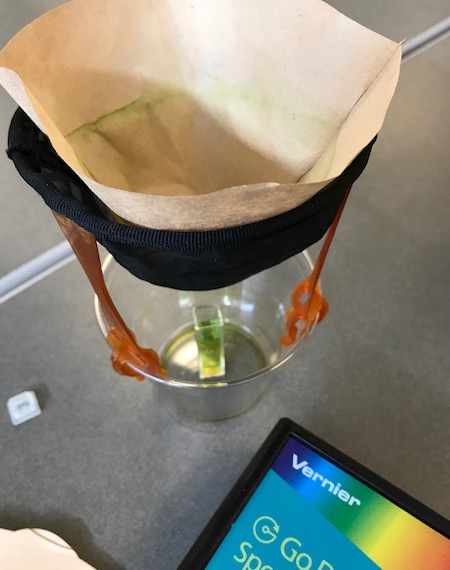
With the cuvette in place and the Go Direct SpectroVis Plus Spectrophotometer warmed up and calibrated, the kale cuvette produced a wonderful spectrum of absorbance highlighting a preference for deep blue, orange. Or essentially anything but green. While running this analysis projected onto a large screen with a classroom full of students, I posed the question of what would the spectrum curve look like for transmittance, or reflectance as we like to think of it.

A volunteered student slowly approached the whiteboard with the giant projected absorbance spectrum curve and tentatively plotted some data points opposite the existing graph. As the mental gymnastics went into overtime, it was clear that the undeniable inverse within science was inescapable. The reflectance could be nothing other than the opposite of the absorbance. After connecting the dots on the inverse plot, an essentially 180 degree-out-of-phase spectrum curve was now gracing the whiteboard. A quick adjustment to the Spectrum Analysis program yielded a transmission curve that matched the student’s work nearly identically. After a brief student OMG moment, the obvious became obvious, and the teaching moment is in the history books.
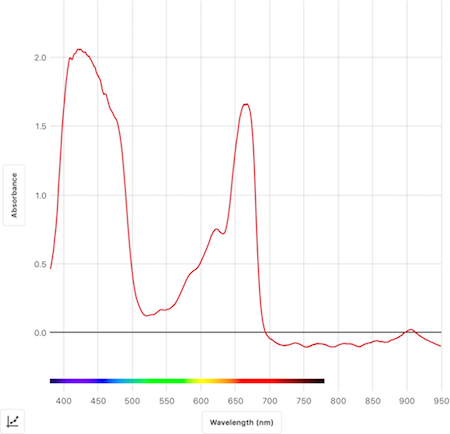
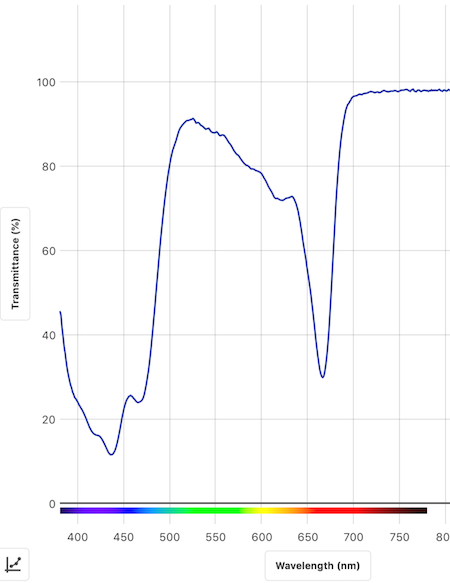
As further emphasis, a second kale cuvette was made that used a diluted version of the kale juice. The pale fluid was used to demonstrate that even a weak solution provides an equivelent spectrum even if that spectrum too was diluted. The limited relief of peaks and valleys in the graph followed the same contours of the initial deep green graph, but with less emphasis. Again, the results matched the expected although for some students it was unexpected.
The Go Direct SpectroVis Plus Spectrophotometer has many uses. Vernier Technology presented several examples of use in their videos. The operation of the Go Direct SpectroVis Plus Spectrophotometer is so streamlined in use in the science classroom that the Go Direct SpectroVis Plus Spectrophotometer is a powerful tool that far exceeds its pay grade. For in reality, as Edith Wharton (the first woman to win the Pulitzer Prize for Literature) noted, “There are two ways of spreading light: to be the candle or the mirror that reflects it.” I guess you could say that the Go Direct SpectroVis Plus Spectrophotometer does both.
Disclaimer: The views expressed in this blog post are those of the author(s) and do not necessarily reflect the official position of the National Science Teaching Association (NSTA).


